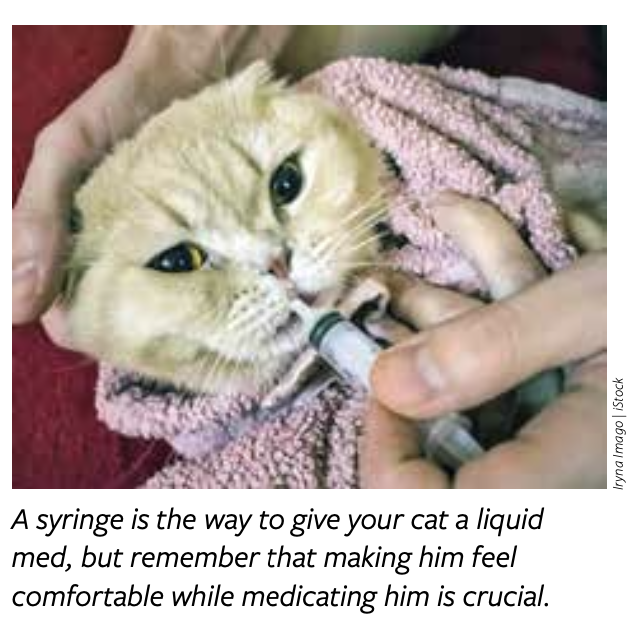Giving your cat medication is often not easy, but it doesn’t have to be traumatic for either of you.
If your cat lives for mealtimes, giving medications with food is often a breeze. For capsules and tablets, simply tuck the medication into a little “meatball” of canned food and serve it to your cat. Just check the bowl when she finishes to make sure she got it all.
For more discerning cats or those who eat dry food, wrap the pill in a special soft treat and give it to her that way. Liquid medications can be served in a bowl of canned food, or mixed in.
Note: Verify with your cat’s veterinarian that the medication can be given with food. Some medications need to be given on an empty stomach, while others interact with specific foods. For example, doxycycline should not be given with dairy products.
Crush and Mix
Some tablets can be crushed and then mixed with food to better disguise them. For capsules, you may be able to either crush the capsule or open it to expose the powder inside.
Note: Check with your veterinarian before crushing a medication. Coated tablets often should not be crushed, because the coating is there to either prevent your cat from tasting the bitter tablet or to ensure that the medication dissolves slowly in the digestive tract.
Treat Toss
You may be able to work a pill into a treat toss game. Start by tossing some hard treats or kibbles for your cat to chase and eat, then toss the pill, followed by more treats. If your cat is really into the game, she hopefully will gulp the pill right down and then look for the next treat.
Manual Pilling
You can give your cat pills by hand, but do so carefully. Place the palm of one hand over your cat’s head and then use the middle finger of the other hand to open the lower jaw gently, while holding the pill between the index finger and the thumb of the other hand. Avoid touching the sharp tips of your cat’s teeth.
Once her mouth is open, drop the pill onto the back of her tongue with your opposite hand. At first it may take a couple tries to master this technique, so be patient. Do not stick your hand inside the cat’s mouth!
Pill Gun
Pill guns are a great tool. They consist of a hollow plastic tube with a silicone tip and a sliding plunger inside.
To load the pill gun, pull the plunger back and tuck the medication into the tip. Then tuck the end of the pill gun into the back of your cat’s mouth by wiggling it between her teeth. Once aimed into the back of the mouth, press the plunger to release the medication. This will trigger your cat’s swallow reflex.
If the pill is dropped too far forward in your cat’s mouth, she will likely spit it out. You want to go as far back as you can without forcing the pill gun. If you feel any resistance, stop.
Note: Choose a pill gun with a firmly attached silicone tip, not a removable one. Removable tips can become dislodged and go down your cat’s throat, leading to a stressful and expensive emergency veterinary visit.
Syringe
Liquid medications are often given with a syringe. Draw up your cat’s dose, and then tuck the tip of the syringe into her mouth. Depress the syringe so the medication squirts onto her tongue.
Small amounts can be given all at once, but break larger volumes into multiple squirts to give your cat a chance to swallow partway through.
To prevent choking, keep your cat’s head level or aimed slightly downward.
Some solid medications can be crushed and mixed with water so you can give them via syringe. Ask your veterinarian if your cat’s medication can be crushed and mixed with water.
Transdermal Formulation
Some medications can be compounded for transdermal application. Instead of getting a pill or liquid into your cat’s mouth, you will be rubbing a small amount onto her ear so that it absorbs through the skin.
Follow dosing and handling instructions carefully so that you are sure that your cat is getting the correct dose and that you are not absorbing any of it. Not all medications can be formulated this way, but it is worth asking your veterinarian about.
Get Comfortable
Eye and ear problems often respond best to medications applied directly at the source. This means placing an ointment or drops into your cat’s eyes or ears.
For most cats, less is more when it comes to restraint for these medications. Wait until your cat is resting in a comfortable spot, then approach and calmly apply the medication.
For ear medications, insert the tip of the bottle into the ear and squeeze out the desired amount, then rub the ear so the medication can soak in. You may not need to hold your cat at all. If you do, gently bracing the opposite side of her head is usually sufficient.
For eye medications, use the thumb and forefinger of one hand to gently separate the eyelids, then apply the ointment or drops. Avoid touching the tip of the bottle to your cat’s cornea (clear coating of the eyeball).
Insulin
Most cats tolerate injections very well. Insulin is given with tiny needles that many cats do not mind. If you are concerned, try giving the insulin injection while your cat is either eating or resting in a favorite spot.
Positive Reinforcement
No matter how you need to medicate your cat, always follow the medication with a reward that your cat enjoys, whether it’s a special treat, toy, or just cuddling. Rewarding your cat allows her to associate medications with something positive, making her more cooperative in the future.




